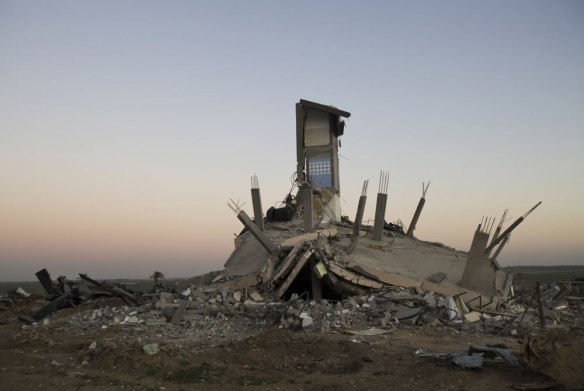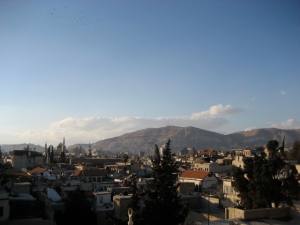
Al-Hariqa after French bombardment in 1925 [Via]
The neighborhood of al-Hariqa at the west end of town is the newest neighborhood in the Old City. A large square is lined with department stores and tailors, and a grid of streets create a neat box of a shopping neighborhood bordered by the late Ottoman-era markets of Souq al-Hamidiyyeh to the north and Souq Madhat Pasha to the south. Need curtains, foam pads, or bubble wrap cut from outsized rolls that stand on the sidewalk? Hariqa is the place. It remains a busy commercial area in Damascus today, and indeed it used to be the busiest of souqs in the city a hundred years ago.
 Damascus in flames, 1925 [From The Great Syrian Revolt, via Google Books]
Damascus in flames, 1925 [From The Great Syrian Revolt, via Google Books]
The change to the neighborhood’s built space was not the result of overzealous government renovation, whether contemporary or late Ottoman. The change came, instead, out of the rubble of French bombs. Following the outbreak of riots in the Jebel Druze south of Damascus that quickly spread to the capital in 1925, the French High Commissioner General Maurice Sarrail responded with an order to bomb the city for 48 hours. Some 1,500 people were killed; houses and other historic buildings, some dating from as far back as the 15th century, were flattened, and the entire commercial heart of the Old City south of Hamidiyya was destroyed. The “garden neighborhoods” of Salihiya and Abou Rumaneh at the foot of Mt. Qassioun were young Damascus suburbs then; Merjeh Square was the recently built, Ottoman administrative center of the city; the Old City was still the heart of Damascus.
When it was rebuilt, with its grid and modern block buildings, the commercial hub took a new name: al-Hariqa, “the Great Fire,” lit by French bombs. It keeps its name today, plainly written on maps.
 A 15th-century house in Hariqa after the French bombs (Photo: IFPO Archives, Damascus) [Via]
A 15th-century house in Hariqa after the French bombs (Photo: IFPO Archives, Damascus) [Via]
In light of architectural preservation worries and a clamor to save the cultural and spatial integrity of the Old City, the destructive remaking of Hariqa confuses things. It sits between the two greatest late Ottoman remodelings of the Old City — Souq al-Hamidiyeh and Souq Medhat Pasha, at the western end of Straight Street. The covered souqs (Mandate-era bullet holes from strafing French airplanes are still visible in Hamidiyeh, pockmarked into arcade’s barrel-vaulted metal roof) replaced the medieval western gates of the Old City, and underline the Ottoman renovations that transformed Damascus in the 19th century. The city was not a backwater then, as some write, and the proof exists in the richness of Ottoman architecture: souqs, schools, palaces, hammams, and residences, all the product of a cadre of Damascene notables and Ottoman governors (a string of ‘Azems in the late 18th century) who wanted Damascus to resemble Istanbul, at least in its public buildings.
But the French obliterated parts of this Ottoman city, resulting in the European style of Hariqa today (a large public square, the axis of a grid of commercial streets). And there was international outrage. Time magazine reported on the “Syrian Scandal” of a League of Nations Mandate authority bombing the oldest continually inhabited city in the world:
“There has never been such a scandal in the history of France!” Premier Painleve, soundly harassed, tried to soothe his public: “Despatches have been greatly exaggerated. . . . Annoying events have taken place in our Syrian Mandate, but the Government is taking necessary steps to remedy the situation.” The “annoying” or “scandalous” events marked the bombing and shelling of Damascus, “oldest inhabited city in the world,” by order of General Maurice Sarrail, French High Commissioner in Syria. Impartial witnesses placed the human loss at 1,000 lives, the property damage at over $10,000,000. L’Echo de Paris cried, last week: “General Sarrail is a senile, stupid, brutal sadist … a criminal … a bloody tyrant!”
… for 48 hours French shot and shell poured into the city; French tanks dashed at full speed through the streets, firing point blank into bazars and houses; and French airplanes dropped bombs.
 Al-Hariqa today [Via Flickr]
Al-Hariqa today [Via Flickr]
Remaking out of rubble is hardly unique. But in the case of Damascus and Hariqa it could have certain meaning. The intact but threatened Old City is an ever-growing tourist and elite attraction, a hub of restaurants and hotels that preserve the traditional Arab house while manufacturing an ideal of the Damascene past for consumption. The entire architectural integrity of the place is protected by Syrian and growing international initiatives — from its UNESCO World Heritage designation, most prominently — so one might be able to say that the country that destroyed part of it in the last century now champions its protection. This is not unique in the post-colonial world either.




































